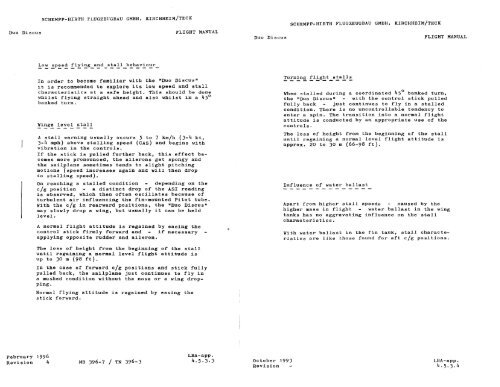SCHEMPP-HIRTH FLUGZEUGBAU GMBH, KIRCHHEIM/TECK ...
SCHEMPP-HIRTH FLUGZEUGBAU GMBH, KIRCHHEIM/TECK ...
SCHEMPP-HIRTH FLUGZEUGBAU GMBH, KIRCHHEIM/TECK ...
You also want an ePaper? Increase the reach of your titles
YUMPU automatically turns print PDFs into web optimized ePapers that Google loves.
<strong>SCHEMPP</strong>-<strong>HIRTH</strong> <strong>FLUGZEUGBAU</strong> <strong>GMBH</strong>, <strong>KIRCHHEIM</strong>/<strong>TECK</strong><br />
Duo Discus FLIGHT MANUAL<br />
February<br />
Revision<br />
In order to become familiar with the -Duo Discus"<br />
it is recommended to explore its low speed and stall<br />
characteristics at a safe height. This should be done<br />
whilst flying straight ahead and also whilst in a 45 0<br />
banked turn.<br />
A stall warning usually occurs 5 to 7 km/h ()-4 kt,<br />
)-4 mph) above stalling speed (CAS) and begins with<br />
vibration in the controls.<br />
If the stick is pUlled further back, this effect becomes<br />
more pronounced, the ailerons get spongy and<br />
the sailplane sometimes tends to slight pitching<br />
motions (speed increases again and will then drop<br />
to stalling speed).<br />
On reaching a stalled condition depending on the<br />
clg position a distinct drop of the ASI reading<br />
is observed, which then often oscillates because of<br />
turbulent air influencing the fin-mounted Pitot tube.<br />
With the clg in rearward positions, the "Duo Discus"<br />
may slowly drop a wing, but usually it can be held<br />
level.<br />
A normal flight attitude is regained by easing the<br />
control stick firmly forward and if necessary<br />
applying opposite rudder and aileron.<br />
The 10s5 of height from the beginning of the stall<br />
until regaining a normal level flight attitude is<br />
up to )0 m (98 ft).<br />
In the case of forward clg positions and stick fully<br />
pUlled back, the sailplane just continues to fly in<br />
a mushed condition without the nose or a wing dropping.<br />
Normal flying attitude is regained by easing the<br />
stick forward.<br />
1996 4 MB 396-7 I TN 396-3<br />
LBA-app.<br />
4.5.3.) October 1993<br />
Revision<br />
<strong>SCHEMPP</strong>-<strong>HIRTH</strong> <strong>FLUGZEUGBAU</strong> <strong>GMBH</strong>, <strong>KIRCHHEIM</strong>/<strong>TECK</strong><br />
Duo Discus FLIGHT MANUAL<br />
When stalled during a coordinated 45 0 banked turn,<br />
the "Duo Discus" with the control stick pulled<br />
fUlly back just continues to fly in a stalled<br />
condition. There is no uncontrollable tendency to<br />
enter a spin. The transition into a normal flight<br />
attitude is conducted by an appropriate use of the<br />
controls.<br />
The loss of height from the beginning of the stall<br />
until regaining a normal level flight attitude is<br />
approx. 20 to )0 m (66-98 ft).<br />
Influence of water ballast<br />
Apart from higher stall speeds caused by the<br />
higher mass in flight water ballast in the wing<br />
tanks has no aggravating influence on the stall<br />
characteristics.<br />
With water ballast in the fin tank, stall characterIstics<br />
are lIke those found for aft clg positions.<br />
LBA-app.<br />
4.5.).4


